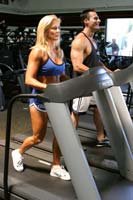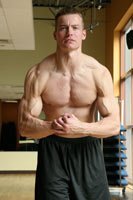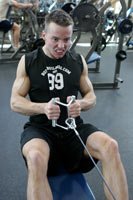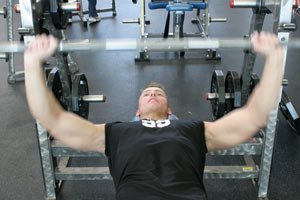
TOPIC: How Should One Alter Their Workout If They Are Not Growing?

The Question:
If you are frequently hitting the gym and not making progress you need to step back and make some changes.
How should one alter their workout routine if they are not growing? Be specific.
What are some reasons why people will stop seeing progress for a period of time?
How important is it to alter the workout if you have stopped growing but still train the same?
Show off your knowledge to the world!
The Winners:
- steveironpump View Profile
- greensquats View Profile
Prizes:
- 1st place - 75 in store credit.
- 2nd place - 50 in store credit.

1st Place - steveironpump
View This Author's BodySpace Here.


Unstoppable Progress 
Training to get big is something that everyone can do, yet very few people know how to actually go about it the efficient way.
A common pitfall that many run into is called a "plateau" or a "rut". Essentially what happens is that the body adjusts to the workout routine that a person is doing and it refuses to build extra muscle mass. Most people get frustrated by this and they wonder why their body won't respond.
If this is you, then here are some simple effective strategies to apply to your workout routine that will get you past that nagging plateau and back into building muscle:

1. Learn The Difference Between Overload And Fatigue:
The most common mistake that people make while trying to build lean muscle mass is they don't know the difference between fatigue and overload. Overload can best be described as placing more stress on a muscle than it can handle. The net effect of overloading a muscle is an anabolic (muscle-building) response from the body.
Optimum overload occurs within the 4-6 rep range with roughly 6-9 heavy sets per muscle. Most people end up doing workouts that consist of high repetitions, which then results in fatigue of the muscle.
The problem with fatiguing a muscle is that it is simply doing just that, making it tired. Fatiguing a muscle also results in unwanted lactic acid concentration in the bloodstream, which impairs proper nutrient transport and thus, it hurts muscle growth.
 |
What Is Lactic Acid? Lactic acid is a chemical compound that plays a role in several biochemical processes. In animals, it is constantly produced from pyruvate via the enzyme lactate dehydrogenase (LDH) in a process of fermentation during normal metabolism and exercise. [ wikipedia.org ]
|
 |
 |
||
The whole idea behind overload is that the body needs a REASON to grow. Doing high repetition exercises doesn't give the body a good enough reason to grow.
It is not to say that someone couldn't build muscle mass by doing higher repetitions because that would be false. However, the main concept we are after here is the most effective way to build muscle mass and avoid a plateau. Therefore, the 4-6 rep range is your best bet.

2. Train Every Body Part Only Once A Week:
It is important to only train each body part once a week when overloading the muscles. This is critical because the body will need that full week to recover completely. This week of rest will allow the muscle to grow much more effectively, since muscle growth occurs after leaving the gym. Lifting weights only prepares the muscle for growth. The actual growing occurs in that time period between workouts.

3. Vary The Routine:
Another very critical component to avoiding a plateau in muscle growth is in relation to the set up of a workout routine. Essentially, the fundamentals of a good workout program should not change. However, the weekly layout should change every 4-8 weeks. For instance, let's say your workout routine looks something like this:
Let's say it has been 6 weeks and it's time to change it up. Changing it up would look something like this:
Besides changing up what body parts get worked on what days, it is also important to change up the specific workouts that are being done for each body part.
For instance, if you are doing a chest workout that consists of bench press, incline bench press, and cable flyes. Change it up. For the next training cycle, your chest workout could start off with an incline dumbbell press. You could then transfer to a dumbbell bench press and then finish off with weighted dips.
By changing up the specific lifts that you perform, you are hitting the muscles with a different stimulus that they are not used to. This will keep your body slightly off balance so that it can't adjust to the workout routine. When the body can't adjust, it can only respond by building more muscle mass.

4. Weak Point Training:
Weak point training takes a certain degree of self-assessment. The idea is to identify the body part that is the most underdeveloped. For instance, if your triceps are preventing you from overloading your chest because they do the bulk of the work during any chest workout, then do triceps on Monday.
Pick the most effective exercises and focus all of your attention on that Monday workout. In the case of the triceps, the most effective workouts to include would be lying triceps extensions (Lying Close-Grip Barbell Triceps Extension Behind Head), triceps pushdowns, and dumbbell kickbacks (Standing Bent-Over One-Arm Dumbbell Triceps Extension).
This concept will play a major role in getting past a plateau especially with a workout routine that involves mostly compound movements.

5. Up The Intensity:
Intensity is probably the most important factor to effective weight training. Bringing a high level of intensity to the gym is a must for anyone serious about building muscle.
Just think about it. The whole concept of weight training is to push the body past its limits. If you walk into the gym with a lazy, sauntering attitude, then how can you expect to take your body to that next level? Your body simply won't respond.
Now imagine that you walk into the gym with a demeanor that borderlines insanity. I'm not talking about getting just a little pumped up. I'm talking about taking your mind to such a state that people will literally think you're insane. If you have no idea what this involves, then go to Youtube.com and watch "Branch Warren Unchained"... you'll know what I'm talking about.
| FEATURED VIDEO | |||
|
Upping the intensity will cause the adrenal glands to release extra adrenaline into the bloodstream. This extra adrenaline will be the difference between performing a set with the same old weight and performing a set with an extra 10 lbs tacked on the bar. Intensity will always be the defining factor of someone who is serious about building muscle.

6. Week Of Rest:
It is very important to take some time off and rest while weight training to build mass. After countless workout sessions, the body eventually gets just plain tired. Taking a week off will allow the body to recover completely. During this week off, the body will actually be in a highly anabolic state and noticeable mass gains usually take place.
A week of rest should be taken at least once every 2-3 months to allow the body to completely recover in between periods of training. Noticeable strength gains also accompany taking a week off.

7. Intense Cardio:
Cardiovascular exercise can help the body pack on muscle more efficiently if it is done correctly. Proper cardio will speed up the body's metabolism of food and will increase the amount of blood in the body. More blood flowing through the body results in more nutrients being processed and allocated for muscle tissue repair and growth
It is a well known fact that cardio anywhere near a weight training session will be highly detrimental to muscle growth. It is also known that cardiovascular activity exceeding 20 minutes is generally detrimental as well. Therefore, a good bar to shoot for is 15 minutes of high intensity cardio that occurs long after a weight training session.
For instance, if your weight training session is in the morning, then do cardio at night or vice versa. It is important to note too that "high intensity" means that you should be breathing very heavily during the session and it should take a little while for you catch your breath afterwards.

8. Check Your Form:
One factor that may not seem like a big deal is in relation to the actual performance of an exercise. Improper form can take the overload off of the intended muscle groups, which results in those groups not developing properly. Strict form is not necessary, but it is important to make sure that the intended muscle groups are being overloaded.
If you are unsure, then have someone watch you and give you feedback to make sure that you performing the movement properly. Most cell phones also have video capability so you could have someone record you performing an exercise as well in order to check your form.
Personally, I can usually tell the next day whether I performed certain exercises correctly because the muscles will either be really sore or they won't seem to hurt at all. If they don't hurt at all, then I will analyze my workout to see what needs to change. Usually, this means a minor reassessment of form or a simple substitution of a good exercise for a bad one that is hard to perform correctly.

Conclusion
The most common reasons why people generally stop seeing results in the gym are very simple and usually consistent. The main reason is probably because there is very little variance in their workout routine. The body adapts and within a month or two, they stop seeing results.
This is why it is critical to outline the fundamentals of a workout program and then make adjustments to the routine so that the body can't quite adjust to what you decide to throw at it.
Another common issue that many people seem to have is that they don't train with enough resistance or with enough intensity. Personally, I don't see how one can expect to build muscle without lifting heavy weight at a high level of intensity. It completely neglects the truth about how the body works.
If you can take anything from all of this, then remember one thing: the body needs a REASON to grow. Heavy weight and a high level of intensity are really the only way to achieve astronomical muscle growth.
Obviously, proper rest and recovery are absolutely critical for success when trying to pack on muscle. The body doesn't grow in the gym. Rather, it grows during the other 23 hours outside of the gym. This only happens as a result of good solid nutrition and a lot of sleep.
Everything outlined above will work extremely well but will only work if rest and recovery are made just as much of a priority as the actual workout itself.
Having your results compromised is very irritating, but I can guarantee you that if you manipulate your workout to fit the guidelines above, then hitting plateaus will be a thing of the past. I have personally witnessed individuals gaining as much as 30-40 lbs of lean mass in a year or less by simply following the same basic idea that I have outlined above. There is nothing to lose. Ditch the plateaus and move on to new muscle growth!

2nd Place - greensquats
View This Author's BodySpace Here.


Introduction
It's a scenario I see all too often. Someone who wants to achieve a body of steel, and yet can't seem to add half an inch of muscle to their frame, and consistently tosses around with the same amount of weight, day in, day out. They become frustrated, most give up, others shout, scream, yell, etc, "What the ---- am I doing wrong!?"
Some will blame their misfortune on genetics, others will take the route of even lamer excuses, such as, "Oh, well it must be because I bought bad oats last week," or something like, "My doctor said that I should really watch my toenail, and I would hate to injure it on an exercise like squats." Exaggeration these are not... seriously.
Guess what folks? Either you suck it up, or get the heck out of the gym. Bodybuilding ain't a sport for pansies. Everything starts with the workout... everything. I don't care how well organized and how strict your diet is, it won't produce squat unless coupled with an intense workout routine.
Now obviously, being lazy isn't the case for some people. A handful of people truly and simply are just not knowledgeable in the ways of bodybuilding and execute numerous mistakes each and every time they set foot in the gym. If either of these people are you, I'm here to help you cure yourselves.

Not Growing
How Should One Alter Their Workout Routine If They Are Not Growing?
How should you alter your workout routine if you aren't growing? Well, it really all boils down to my acronym: DEDICATION. Here's what each letter stands for.

D - The First D Stands For Desire:
When you step into that gym, you have to want to grow muscle more than you've ever wanted anything. You need to come with a fire lit under your @ss, and when it gets a little painful, you just need to pretend your life is on the line.
What are you going to do? Give up? H^ll no! You have to want that last rep more than life itself. Grind, push, finish what you started! Don't give up! Have a desire to finish and grow muscle.

E - The E Stands For Expand:
If you're not growing, you should expand your exercise arsenal. Add in some new exercises your muscles have never seen before to attack and destroy your body parts in synergy with ones you already have.
For instance, already have barbell curls for your biceps? Good, now add in some alternating dumbbell curls, throw in some hammer curls, and heck, add some preacher curls while you're at it. All of these will target the same general area and work with the barbell curls you're already performing to rip up your muscle fibers for some exponential growth!

D - The Second D Stands For Determination:
Are you going to walk into that gym with a yellow smile painted on your face? I think not, at least you'd better not. Walk in there with your game face on, tense and tighten up those face muscles. Get mean!
Be determined to lift some grueling, heavy freaking weight. Don't chat on the phone while you're at it, this is some serious business! Start pretending someone's holding your head under water and the only way to escape that ice-cold grip of death is to pull some iron. Now what the heck are you going to do!? You HAVE to get determined to lift some weights.

I - The First I Stands For Intensity:
Chances are, if you aren't growing, you're workout isn't intense enough. I don't care how much your muscles burn afterwards, or how big the pump is, you think that'll build bundles of muscle? Heck no! I want your muscles to literally scream at you!
You should be sweating like a big and be taking heaving breaths while you wiggle on the floor. Heck, "I" should in fact stand for insanity, because that's how you need to train if you are really and truly serious about packing on some dense, hard muscle. Go read these articles until you understand what I mean, and then let's talk.
| FEATURED ARTICLE SERIES | |||
|
Author: AnimalPak |

C - The C Stands For Create:
Create a goal sheet, both containing long- and short-term goals, and work to achieve them. Create a plan of attack. Don't just walk into the gym, slap on some weight, hit some random exercise, call it a day, go home, and expect to grow.
Print out a sheet of your exercise routine for the next month, and hit the gym hard. Create a log. Logging your workouts will encourage you to break last session's peak and push you to make great gains.
Create a reason why the heck you're doing all of this in the first place, make sure you understand it, and bust your butt in the gym until you have to create a new reason. Strive to create that new body.
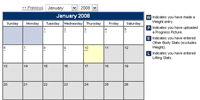 |
BodySpace Workout Tracker: Set Up A Routine And Stick To It! With BodySpace you can track your routine day by day and keep yourself from slipping up. [ Sign Up For Your Own BodySpace Account Here! ] |

A - The A Stands For Attitude:
You want to come determined, but at the same time don't be a cocky son-of-a-(blank). Let your actions do the talking, not that fat hole near the bottom of your ugly face.
Don't walk in the gym cussing up a storm and flinging the weights around. What does this have to do with not growing? Because dang it, you're usually so worried about your ego and being a tough-guy with this kind of an attitude that you aren't even doing anything right! So please, come with a respectable attitude.

T - The T Stands For Technique:
Don't just fling the weights around. Use proper technique, and if you don't know what that is, research right here on Bodybuilding.com. They have a great exercise database with pictures and videos to show you how to perform each and ever repetition to perfection.
Another quick tip is to squeeze your targeted muscle all the way up and down. Pretend like you are driving a destructive lawn mower within your muscle and you need to really tear up the fibers within.
Just squeeze the heck out of them so that a 20 pound dumbbell feels like 1,000 pounds. Remember, your goal is not to see how much weight you can life, but to build muscle. Plus, even if it is your goal to lift a lot of weight (powerlifters) you too will become stronger by performing proper technique.

I - The Second I Stands For Isolation:
If you aren't growing the desired muscles, make sure you are actually working the correct muscles you want to grow. For if you isolate the muscles you really need work on and attempt to use those as much as possible during a certain exercise, chances are you are stimulating them for growth more than if you just let a bunch of other muscle groups lend a hand.

O - The O Stands For Overtraining:
Overtraining is something you want to avoid for the most part. Now, this is not to encourage you to use this as an excuse to not workout by any means, but rather a precaution that must be taken "IN THE INSTANCE" that you are working out 8 hours a day 7 days a week, or something of the likes.
Even worse would be if you train the same muscle group each time. People, you NEED rest to grow. Train intensely while you're at the gym, don't stay longer than you have to, though.

N - The Last And Final Letter, N, Stands For Nutrition:
What does this have to do with the workout? Simple. Make sure you include proper intra- and post-workout nutrition in your routine if you expect to grow. Your muscles are getting torn, now they need nutrients to prepare, and during/after an intense workout is the best time to give them to them, for they will soak them up like a sponge.

 Dedication:
Dedication:
And then of course, who could forget the acronym: dedication. Slow and steady wins the race. Be consistent. Stay with it, don't give up. Continue your research. And of course, have a will to grow.

Reasons Why
What Are Some Reasons Why People Will Stop Seeing Progress For A Period Of Time?
People will stop seeing progress for a period of time for many reasons, most frequent of which is the instance of plateau. Plateaus themselves are most often caused by a lack of variation in the routine. For instance, if you continually perform the exact same schedule (back/biceps day one, shoulders/legs day 2, etc.) with the exact same exercises day in and day out, your body will gradually become used to the tolls and will stop growing and increasing in strength for a period.
Ways to solve and prevent this from happening is simply by switching up your exercise. You can do this through letter E of the DEDICATION acronym, which explains to expand your exercise arsenal.
Another reason why some people will reach plateaus and in essence will stop seeing progress is because they are not training intensely enough, which brings us back to letter I of the DEDICATION acronym. Remember, you have to bust your butt each and every time you are in the gym, and not just in the beginning if you are expecting continual growth.
The third most common reason people will stop seeing progress is from overtraining, which can be understood through letter O. Again, this is not meant to be an excuse, but rather a precaution for you more avid and excited gym-goers.
Really, all of the letters from my acronym can be tied with plateaus, however the three I've just outlined seem to be the most common.

Altering The Workout
How Important Is It To Alter The Workout If You Have Stopped Growing But Still Train The Same?
It is not just important to alter your workout if you have stopped growing, it is crucial. I don't see how continuing with the same routine can even be an option. It's like going to a dry well, I mean at some point you have to say "Hey! I'm freaking parched as heck, but that well isn't providing any water. I'm going to find another well."
Another example is banging your head against a wall constantly. Here, at some point it has to hurt enough to where you quit and do something else. Well, the same applies to workouts. If the workout has stopped producing results, simply switch it up and alter it to something that does!
Hope this has helped folks, that's all for now.
Eat hard, rest hard, train hard. - greensquats




